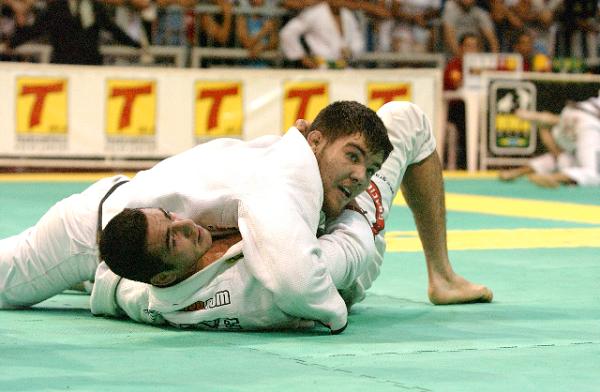
Robert Drysdale atop Bráulio Estima as brown belts at the 2003 World Championship / Photo: Gustavo Aragão/GRACIEMAG.com
When you let a Jiu-Jitsu fighter make it to side-control,it’s an indication that he’s heading in the right direction—and that you’ve got problems on your hands. He has passed your guard, amounting to three points on the scoreboard, and now he’s all set to mount and/or finish you. Both at tournaments and in training, the chest-on-chest position causes discomfort, and if the guy on top drops his hips the pressure becomes all the greater.
To review the position, start by studying the attack, as our GMA in Texas João Crus did, teaching two attacks from side-control and even a trick to thwarting an attempt at a reversal.
Now, GRACIEMAG.com lays out 5 important lessons for you to get out from between a chest and a hard place, provided by some stars of gi-clad combat.
1. DON’T CLUTCH YOUR OPPONENT TO YOU
As pointed out by João Paulo Marques, a black belt from Mossoró Combat and training partner to the UFC’s Gleison Tibau, “Ideally you wouldn’t let your opponent get to that position. But once he’s there, never clutch him to you. Try hiding your neck and arms, and try to get him away from you so you can replace guard.” Should your opponent clutch your neck, João Paulo suggests you pummel your arm under for an underhook and slide to his back. “It’s a clever and really efficient escape.”
2. DON’T JUST SIT THERE, GET MOVING
“Always keep moving so as not to let your opponent be at ease,” recommends Rodrigo Comprido. “Shrimp out your hips to open up the room needed for escape,” says the two-time absolute world champion, one of the main draws of the 2012 Pan and inaugural World Jiu-Jitsu Expo.
3. ELBOWS NEAR YOUR KNEES
“The most important thing to do to not get trapped in side-control is to use your elbows and knees as protection,” asserts Renato Tavares of ATT Vero Beach. “Always keep your elbows near your knees, not leaving room for your opponent to exert control, and making room for you to escape or sweep.”
4. STRING TOGETHER SEVERAL ESCAPES
“In side-control, the best hint I can give is for you to not stop moving when your opponent is passing,” says Jonatas Novaes, winner of the absolute division at the Chicago Winter Open. “Don’t let him settle in just because he’s got your side. At that moment that he’s arriving there he’s still not firm in the position, so it’s easier for you to get out. Now if he’s already passed and scored the points, you’d best take a breath and wait for the right moment to explode out of there. Try combining several escapes, making him defend a lot and open up room for you to replace guard or half-guard. Don’t forget to protect your neck and arms to keep from getting tapped out.”
5. WATCH HOW TO PRESS FOR GUARD REPLACEMENT
Professor Marcos Schubert of Gracie Barra Curitiba has posted a number of techniques on YouTube.com, and in the video below he shows how to wriggle out of side-control. Schubert highlights the importance of placing one hand on the shoulder and the other on the hip, pressing away to open up room with which to shrimp out your hip and replace guard.
What do you think, gentle reader, what’s the best escape route for this predicament? Share with us in the comments section below.



